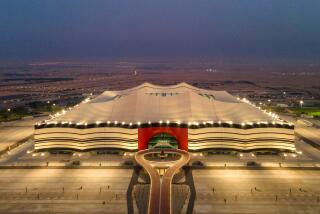China’s footprint in Pakistan
- Share via
GWADAR, PAKISTAN — Along a scenic beach where fishermen mend their nets by hand, an endless row of storefronts stretches into the distance, all selling the same thing. Not sunscreen, umbrellas or cold drinks. Land.
Never mind that the area is home to a violent separatist movement, or that foreigners are regarded with suspicion by police. A property boom has hit this formerly sleepy town in southwest Pakistan because of the latest addition to Gwadar’s modest charms: a strategic new port on the Arabian Sea, almost all of it paid for by China.
The deepwater port has the potential to become a major shipping hub for Central Asia and China, particularly for the oil that China is sucking up to fuel its explosive growth. Gwadar, near the Iranian border, sits close to the entrance to the Persian Gulf and the Middle East, China’s biggest source of crude.
But officials in countries such as India and the United States are eyeing the port warily, seeing more there than mere commercial value.
They fear its possible future use as a base for Chinese ships and submarines, given the close ties the governments of China and Pakistan have enjoyed for decades. From Gwadar, analysts note, China could project its growing economic and military might westward, toward the Middle East, western India and eastern Africa, and down into the Indian Ocean.
An internal Pentagon report leaked two years ago concluded that China was trying to establish a “string of pearls” along the rim of the Indian Ocean, ports that it eventually could use for military purposes. Besides Gwadar, Beijing has invested in ports in Myanmar, Bangladesh and Sri Lanka.
“At the moment, these are [just] fears,” Ashley Tellis, an Asia expert at the Carnegie Endowment for International Peace, said of potential Chinese military use of Gwadar’s new port. “But there is no logical reason why the Chinese would not contemplate the military benefits of such a facility for the long term.”
That Beijing considers the port in its national interest is amply demonstrated by the fact that it put up 80% of the $250 million in construction costs, is funding a new airport here and dispatched its communication minister to witness Pakistani President Pervez Musharraf inaugurate the port last month, with great fanfare.
“It is the friendship between China and Pakistan that has made my dream of Gwadar come true,” Musharraf said. “We thank you. We thank China.”
The idea of building a port at Gwadar has floated around in Pakistan for decades. It took on added urgency after the Indian navy blockaded Karachi, Pakistan’s largest port, during a war between the two rival countries in 1971. But it was Musharraf, more than a quarter of a century later, who made a major push to get it done.
Backers of the project entertain visions of Gwadar as a new, more convenient gateway for trade from Chinese and Central Asian markets to points west. For China, closer access to the sea from its landlocked western territories, where a massive development campaign is underway, can save thousands of miles and days of travel for goods that would otherwise have to exit the country from the east on a much more circuitous route.
Optimists also hope that bringing prosperity might drain away some support for a militant secessionist movement here in Baluchistan province that has given the Pakistani government headaches for years. This rugged region is rich in resources, including large natural gas reserves, that the government in Islamabad would like to tap. But many Baluchis -- ethnically different from the Punjabis who people the corridors of power -- fear being unfairly exploited.
Construction of the port has been plagued by problems that do not augur well.
Delays in completing infrastructure works pushed back the port’s planned opening by more than a year and reportedly triggered complaints from the Chinese side. Security became a big issue when, in May 2004, three Chinese engineers were killed in a car bombing.
Even now, rifle-toting soldiers and police officers are common sights, their dark uniforms stark against Gwadar’s dramatic backdrop of jagged chalk-colored cliffs, deep blue sea and a colossal rock formation that thrusts into the ocean like a giant’s arm.
Despite the image of welcome that officials are trying to cultivate to attract investors and visitors, the security forces sometimes operate with a heavy hand. When an American reporter tried to visit Gwadar a few days after the port opened, police officers and intelligence agents stopped him at the airport and confined him to a hotel for several hours until U.S. diplomats and apologetic Pakistani officials in Islamabad intervened.
In a recent editorial, the respected Dawn newspaper said the government had to ensure that local residents benefited from the port if it hoped to dilute resentment of its rule.
Any significant recruitment of skilled or semiskilled labor from other parts of the country “will be seen by the local people as an attempt to deprive them of employment opportunities now that they have at long last come to their area,” the paper warned.
Because there is currently little industry in Baluchistan to take advantage of the port, some analysts predict that it could take years before the economic benefits become widespread.
For China, the advantages of the new port are obvious.
Gwadar would provide a more secure corridor for China’s fuel and energy supplies in the face of instability in the Persian Gulf and also down in the pirate-infested Strait of Malacca, by Indonesia, through which 80% of China’s oil imports now pass. From Gwadar, imports could travel overland up through Pakistan and into China.
Trade out of China’s own restive western region of Xinjiang would also be easier and faster. The distance from Kashgar, on the edge of Xinjiang, to Gwadar is 1,250 miles, versus twice that distance to reach Shanghai.
Some analysts see a more strategic interest in Gwadar. They say it could play host to Chinese vessels, listening stations or an outpost from which Beijing could monitor the Persian Gulf and the Indian Ocean, including the U.S. Navy base on the remote island of Diego Garcia, a key launching pad for operations in the Persian Gulf.
But a beefed-up Chinese military presence in Gwadar probably is years away, if it happens at all.
“I’m extremely doubtful the Pakistanis will allow the port itself to become a Chinese base,” said Pervaiz Iqbal Cheema, president of the Islamabad Policy Research Institute. “Pakistan and China are extremely close, and they would probably look after each other as much as their national interest permits. If our national interest permits that we go all the way, we may, but I’m skeptical about it.”
At the moment, the mad dash in Gwadar is not about geopolitics but about capitalizing on exploding land values. Eager speculators and investors from Islamabad, Lahore and Karachi have flocked here; billboards tout shiny new housing projects yet to be built.
The brochure for Gwadar Florida City entices buyers with an imaginary future skyline that looks suspiciously like Miami’s. When the company’s first housing development went on sale in 2003, buyers snapped up 500 plots in three days, said local representative Abdul Hameed. Those parcels, each measuring 4,500 square feet and costing about $8,300 then, can go for four times that amount now.
Even some fishermen have noticed a rise in their fortunes.
“When we used to catch fish, there were no takers -- we used to throw away half our catch,” 55-year-old Mohammed Ibrahim said as he rolled up his nets, the sharp tang of brine in the air.
Recently arrived wholesalers now buy up Ibrahim’s haul and send it off to Karachi. He has made enough money to buy a second boat. And he’s not worried about migrants moving to Gwadar and horning in on his business.
“People are coming from outside,” he said, “but the sea is so big we don’t have a problem with that.”
More to Read
Sign up for Essential California
The most important California stories and recommendations in your inbox every morning.
You may occasionally receive promotional content from the Los Angeles Times.














